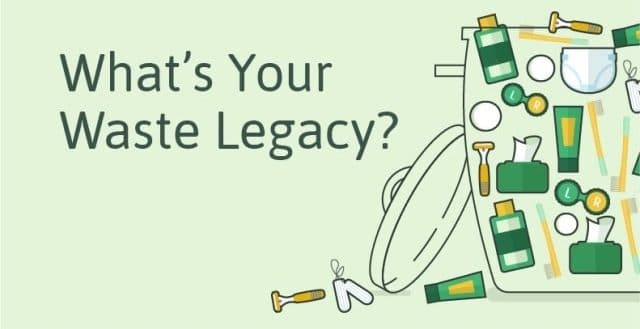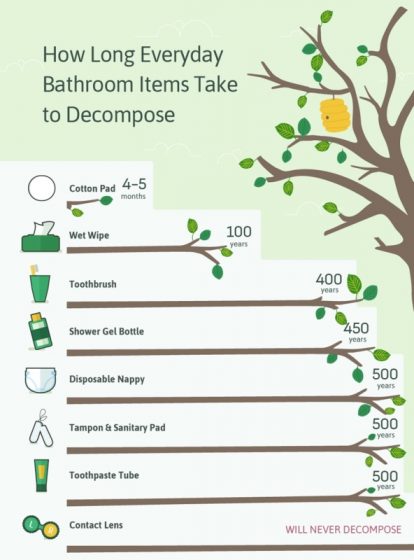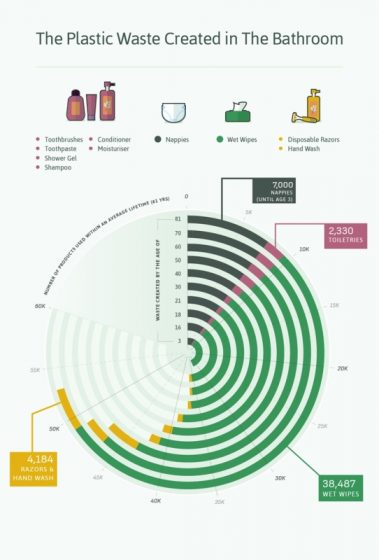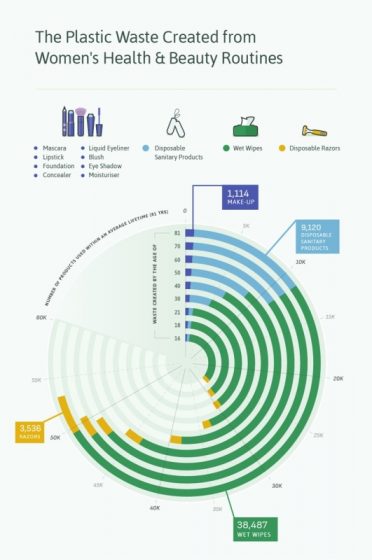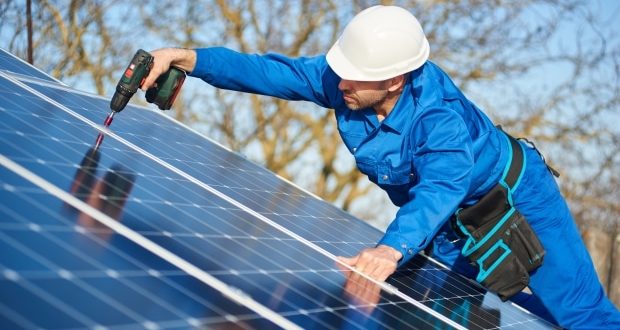Most of us like to hope we’ll leave a certain impression or legacy when we’re gone, or things like a financial safety net for our children. But, what we’re most likely to leave is a toxic plastic footprint.
Whilst 90% of packaging is recycled in our kitchens, only 50% is being recycled in the bathroom. As a result, our recyclable bathroom waste accounts for 30% – 40% of total landfill waste in the UK.
Although most of us are aware of the damage plastic causes to the environment, what you probably don’t know is the plastic pollution you’ve created on a personal level. That’s why Tap Warehouse have uncovered the waste created from the bathroom at every age milestone.
Read on to discover what waste you’ve created so far, and how much you’ll generate in your lifetime.
The Waste Legacy of our Everyday Bathroom Products
The amount of plastic products and packaging in the bathroom is startling; most of these products contain plastic in some way. The toothpaste tube you’ve used today, perhaps even whilst reading this, will still be on this earth in 500 years time, long after you’re gone.
Even the disposable nappy you used as a baby is still on this planet and will be for hundreds of years. But have you ever wondered why these products take so long to degrade?
The disposable nappy was created in the 1950s as a more secure and leak-proof alternative to the reusable nappy. However, the convenience and efficient design of disposable nappies is actually part of their downfall; 23% of a nappy is plastic sheets to prevent leaks, 7% is elastics and adhesives.
Then the majority (70%) of the nappy consists of an absorbent pulp, but even this contains plastic; a super-absorbent polymer to soak up wetness. All of this plastic results in each nappy taking up to 500 years to degrade, as unfortunately it cannot be recycled.
What’s more, women’s intimate health products are deceivingly made up of a lot of plastic too – also taking up to 500 years to decompose. Surprisingly, sanitary pads consist of 90% plastic with one pack (of 12 pads) containing as much as 4 plastic supermarket bags.
Whilst tampons are made of cotton and rayon, they still comprise of plastic – even in the string. In total 6% of a tampon is plastic. Wet wipes take less time to decompose than some other bathroom products, but they still wreak untold harm on the world’s environment – and take 100 years to degrade.
Even if you used one 10 years ago, it’s your grandchildren who’ll be dealing with the damage, as they take 100 years to degrade. But what makes these wipes so harmful? Whilst they’re made of cotton, they also contain the synthetic fabric, polyester – which takes years to deteriorate.
The UK’s Average Bathroom Waste Weighs 33 Million Tonnes
The bathroom waste we have created in our lifetime will weigh 512kg, and by the UK’s population, that’s a whopping 33,812,480 tonnes – the same weight as 300 blue whales.
From the first moment we grace this earth, we start our waste legacy through the use of disposable nappies and baby wipes. Then as we grow every year, so does the waste we’ve generated.
To break this down, Tap Warehouse have calculated the number of products the average Brit will have used at the following ages:
- 3 years old – 32,074 items of bathroom waste.
- 16 years old – 35,396 items of bathroom waste.
- 18 years old – 35,910 items of bathroom waste.
- 21 years old – 36,681 items of bathroom waste.
- 30 years old – 38,994 items of bathroom waste.
- 40 years old – 41,564 items of bathroom waste.
- 50 years old – 44,134 items of bathroom waste.
- 60 years old – 46,704 items of bathroom waste.
- 70 years old – 49,274 items of bathroom waste.
- 81 years old – 52,101 items of bathroom waste.
Unfortunately, 50% of these products end up in a landfill. And even then, each product can take hundreds of years to decompose, and easily surpasses our time on earth.
The Average Woman Creates 52,000 Items of Cosmetic & Hygiene Waste Over Their Lifetime
The beauty world is filled with products covered in pretty packaging aimed at makeup lovers – which seems to work considering the British cosmetics industry is worth £17 billion.
However, behind all of these luxurious products and packaging is a sea of toxic plastic waste, which isn’t very pretty at all. Every year, over 120 billion units of packaging come from the cosmetics industry – most of which isn’t recyclable.
So, when women reach 81 years old they would have produced over 52,000 pieces of plastic waste – just from their makeup and menstrual cycle.
To help women uncover their bathroom waste legacy, Tap Warehouse have calculated the number of products the average woman will have used at each of the following ages:
- 16 years old – 28,582 cosmetic & hygiene products.
- 18 years old – 29,532 cosmetic & hygiene products.
- 21 years old – 30,957 cosmetic & hygiene products.
- 30 years old – 35,232 cosmetic & hygiene products.
- 40 years old – 39,982 cosmetic & hygiene products.
- 50 years old – 44,732 cosmetic & hygiene products.
- 60 years old – 47,322 cosmetic & hygiene products.
- 70 years old – 49,672 cosmetic & hygiene products.
- 81 years old – 52,257 cosmetic & hygiene products.
If you break this down, the average woman produces 527 items of cosmetic and hygiene waste every year.
40% of Brits Don’t Regularly Recycle Bathroom Products
4 in 10 Brits confess to not regularly recycling bathroom items. As a result, 30,000 tonnes of recyclable bathroom items end up in landfill every year. That’s the same weight as three Eiffel Towers.
To encourage Brits to implement a better recycling routine in the bathroom, Tap Warehouse have uncovered some tips.
Use a Second Bin – A lot of us have two bins in the kitchen – one for waste and one for recyclables. The same can be applied to the bathroom, fill your recycle bin with cardboard and plastic bottles.
Hang a Cloth Bag – If you have little space, you could always hang a bag on the back of a door, or a towel hook to place your recyclables in. This saves floor space and you can find a bag to match your bathroom with so many stylish bags on offer.
Check the recycle symbols on your products – You may be surprised by how many items can be recycled in the bathroom – such as toilet roll tubes, deodorants, shower gel bottles and more. Whenever you finish a product, make sure to check the recycling symbol before binning it.
Recycle your contact lenses – Never put your contact lenses down the sink or toilet. They post a threat to aquatic life once in the sea and ocean. Thankfully, Boots have now started a lenses recycling scheme, where contact wearers can drop off their lenses at over 1,000 public drop-off points across the UK.
Revealed: 8 Ways to Reduce, Reuse and Recycle Your Plastic Bathroom Products
Switching out plastic in the bathroom doesn’t mean you have to compromise your beauty and health regime. We’ve listed the top 8 swaps so you can have an eco-friendly bathroom.
Recent research from Tap Warehouse around Brits’ Bathroom Habits revealed that most Brits regularly wash their hands. Whilst this is hygienic, it, unfortunately, means we generate a lot of plastic waste from handwash.
As an eco-friendly alternative, we could switch to a bar of soap. Not only do they have less plastic packaging, but on a per-wash basis, their carbon footprint is 25% smaller than hand wash. This is due to hand wash needing up to 20 times more packaging, which ultimately means more waste.
Additionally, switching out wet wipes can be massively beneficial to the environment. Wet wipes take up to 100 years to decompose. They’re also the cause of 93% of sewer blockages – costing the UK £100m every year.
Thankfully, there are efficient alternatives, like micro-fiber or face cloths that can be washed and reused. No matter how big or small your waste legacy is, we have all contributed to the plastic footprint on earth in some way.
In the bid
The good thing is that a lot of the UK are increasing their recycling habits. In 2000, Brits recycled just 10% of waste, however in more recent years this has increased to 45%. But that’s not to say we shouldn’t try.
There are still more ways we can make a change, like buying refillable or in bulk. You can also check your local council for what can and cannot be recycled.
Reusing some things you definitely won’t need anymore is always fun. You can also turn it into an interesting do it yourself project with your kids. Here are easy tips to teach your children to go green.

